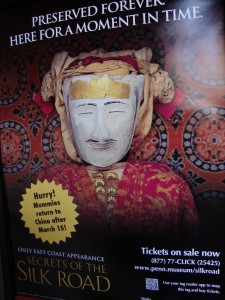Just For Fun: Yummy Mummy – Secrets of the Silk Road
Victor Mair scored a major victory with “Secrets Of the Silk Road,” an exhibit at the Penn Museum featuring some of the world’s best preserved mummies. It was a hard fought battle as the Chinese government almost, once again, snatched the mummies from Mair’s grip. For China, these mummies, found in present day Xinjiang province and as old as 4,000 years, challenge the delicate narrative that China has created for itself.
The Chinese believe that their culture developed, during its formative years, completely independent of all other cultures and therefore the Chinese culture emerged without any interaction from the West. But these mummies call such a narrative into question. With red hair and Caucasian features, the mummies were found in present-day China and with the oldest dating back to 1,800 B.C. these mummies would have been in Chinese territory during the formation of the Chinese culture. For the Chinese government, these mummies remain extremely controversial.
And their existence in Xinjiang creates an alternative narrative for the Uighur’s, a distinct ethnic group from the Han Chinese. The Uighurs have used these mummies to lay claim to their “Western” heritage. While DNA studies have disproved this theory, the fact that the Uighurs ardently maintain this belief is a worry to the Chinese government who see the Uighers as a separatist group.
Not surprisingly, China was not proactive in letting anyone know about these mummies. In fact, if Mair hadn’t stumbled upon these mummies in the backroom of a museum in remote Xinjiang in 1987, its questionable if the rest of the world would ever know about these red-headed Chinese mummies.
But after years of trying to hide these mummies, the Chinese government finally allowed two of them – the Beauty of Xiaohe and an infant baby – to travel to the United States. However, when they moved to the Penn Museum a few weeks ago as the crowning jewel in Mair’s “Secrets of the Silk Road,” the Chinese government was threatening to pull the mummies from the exhibit. Fortunately for us, Mair was able to convince the Chinese government to allow the mummies to be shown for a limited time. For 15 days only – until March 15 – the mummies are on display.
Last Saturday I was able to see the mummies and experience the “Secrets of the Silk Road.” At $22.50 a pop, I was looking to get my money’s worth and with the mummies on display, I certainly did. The Beauty of Xiaohe has a full head of red hair, high cheek bones of a caucasion and eye lashes that make me jealous. If you are going to visit this show – and you should – definitely get there before the mummies leave on March 15.
The rest of the show does a poor job of explaining why these mummies are so amazing and yet so controversial for the Chinese. One of my museum companions noted that with the limited explanations of the history of the region, to truly get the most of the exhibit, a visitor must already have a significant amount of knowledge of the region. It looks like the Penn Museum missed an opportunity to educate the populace about this fascinating area of the world; a good portion of the show’s visitors were 10 year olds there to see the mummies. In a similar vein, the lack of a map in the rooms proved distressing even for someone familiar with the region. The lack of a map at all points during the exhibit was a complaint I heard from a good number of visitors.
Aside from the mummies which were around 4,000 years old, most of the artifacts were of a more recent vintage, specifically from 600 to 800 AD – China’s Tang Dynasty – during the height of trade between China and the West. By 600 AD, the Chinese culture is fully formed so the interaction with the West during the Tang Dynasty is not a challenge to China’s current narrative. So these artifacts are hardly controversial.
With the mummies, this show is a must see. Without the mummies, the fact that much of the artifacts are from 700 AD provides a less compelling reason to go to the show (presumably the price will go down without the mummies). It is though a great show for children. There are games that children can play throughout the show, signage in many places are at the height level of an 11 year old, and even a trivia game at the end of the exhibit. One of the ending signs, in explaining how a mummy is created, noted that “a raisin is a mummy you can eat.”
If you do go to the museum and have time to kill, the Buddhist sculpture section on the 3rd floor is a must see. Beautiful pieces from the artistically high point of Buddhist art in China – the Tang Dynasty.
Finally, be sure to finish up your tour with a yummy cheesesteak at Abner’s just down the block.
Mummies – Rating: 




Show without the mummies – Rating: 




Penn Museum
3260 South Street
Philadelphia, PA
Mummies on view until March 15
 On Facebook
On Facebook By Email
By Email 
